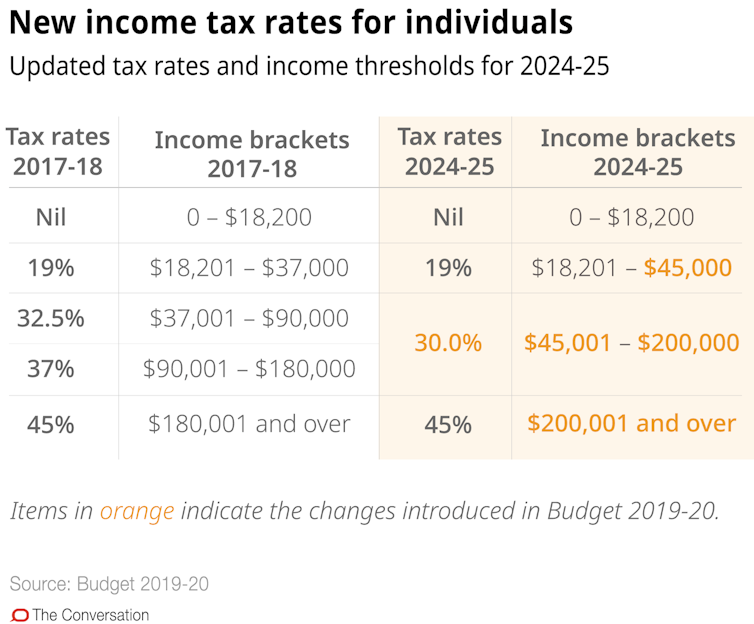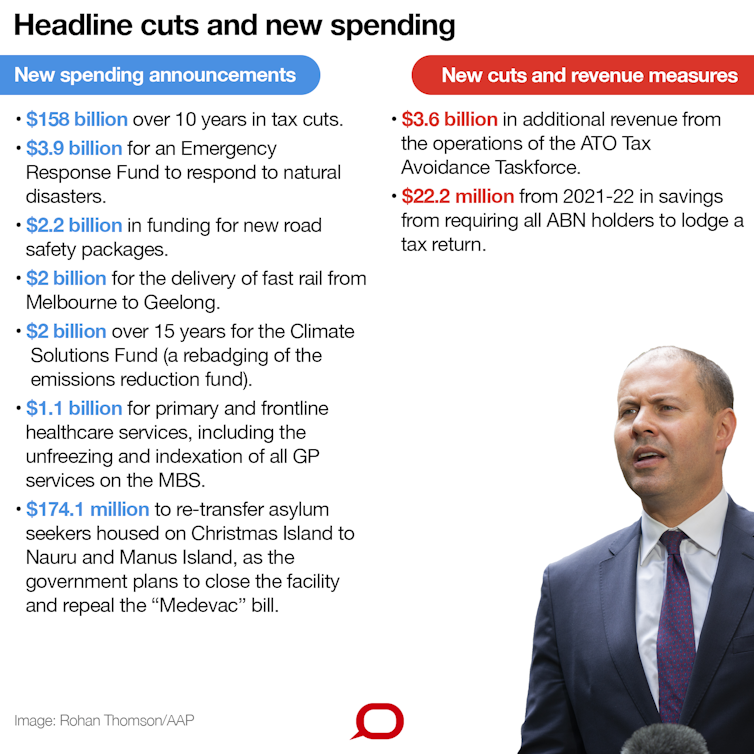Michelle Grattan, University of Canberra
The Morrison government has delivered an election-launch budget with big personal income tax handouts to attract voters and a A$7.1 billion 2019-20 surplus to display its economic credibility.
The budget – the first brought down by Treasurer Josh Frydenberg – doubles the tax relief that average earners were due to receive within weeks, from $530 in last year’s budget to $1,080.
This outbids the relief that Labor promised last year. But the opposition immediately announced it would support the tax cuts that begin on July 1 “for working and middle-class people”.
“This is essentially a copy of what we proposed last year, and they are simply catching up to us,” Labor’s Shadow treasurer, Chris Bowen, and finance spokesman, Jim Chalmers, said in a statement.
“The Liberals are so out of touch that they’ve given a much smaller tax cut to two million Australians earning less than $40,000. Labor will fix this and give these working people the tax relief they deserve,” Bowen and Chalmers said.
Read more: View from The Hill: budget tax-upmanship as we head towards polling day
People with incomes between $48,000 and $90,000 will be eligible for the maximum $1,080. About 4.5 million people will receive the full benefit.
In July 2022 the government will lift the top threshold of the 19% tax rate from $41,000 to $45,000
From July 2024 it will cut the rate of the middle tax bracket from 32.5% to 30% – leaving a rate of 30% between $45,000 and $200,000, beyond which it will be 45%.

The cost of the tax relief is $19.5 billion over the four-year forward estimates period and $158 billion over a decade.
Frydenberg told parliament: “The budget is back in the black and Australia is back on track.
“For the first time in 12 years our nation is again paying its own way.”
Earlier, in the government parties’ meeting, Scott Morrison told his MPs the available election dates were May 11, May 18 and May 25 and he would determine when the election would be in a short while.
The surplus of $7.1 billion is for the coming financial year. In the current year, ending June 30, the budget is expected to come in with a deficit of $4.2 billion.
Read more: Iron ore dollars repurposed to keep the economy afloat in Budget 2019
The surpluses will build over time – projected to total $45 billion over the next four years. “Surpluses will continue to build towards 1% of GDP within a decade,” Frydenberg said. The government’s goal was to eliminate Commonwealth net debt by 2030 or sooner.
He said the government’s economic plan restored the nation’s finances without increasing taxes, strengthened the economy and created more jobs, and guaranteed essential services, while tackling the cost of living.
For the 2019-20 year, economic growth is forecast at 2.75% and wages are forecast to increase by 2.75%. Unemployment is expected to be 5%.
One major saving in a budget that avoids widespread cuts is changing the social security income assessment model, saving more than $2.1 billion over five years.
The change will simplify and automate the reporting of social security recipients through the Single Touch Payroll. From July 2020, recipients who are employed will report income that is received during the fortnight rather than calculating and reporting their earnings. The government says this will greatly reduce overpayments.
The budget anticipates a substantial amount of additional revenue – $3.6 billion through cracking down on tax avoidance by large corporations, multinationals and high-wealth individuals.
As the government flagged ahead of the budget in a series of specific announcements, the budget includes an extensive infrastructure program, which it says it has boosted to $100 billion over the decade.
Frydenberg announced a four-fold increase in the Urban Congestion Fund – from $1 billion to $4 billion.
The fund will include a $500 million Commuter Carpark Fund to “improve access to public transport hubs and take tens of thousands of cars off our roads”.
Budget measures also target small and medium-sized businesses with an increased and expanded instant asset write-off. The write-off will rise from $25,000 to $30,000 per item and be extended to businesses with a turnover of up to $50 million.
There would be a $525 million skills package, including the creation of 80,000 new apprenticeships in industries with skills shortages. Incentive payments to employers will be doubled to $8,000 per placement. New apprentices will also receive a $2,000 payment.
Ten new training hubs will be established connecting schools, local industries and young people in regional areas with high youth unemployment. The government is also promising $62 million to boost students’ literacy, numeracy and digital skills, as well as further funding to increase the participation of women and girls in science, technology, engineering and maths.
There is also $453 million to extend preschool education, enabling 350,000 children to have 15 hours of early learning a week in the year before school.
Responding to Labor’s promise to unfreeze the Medicare rebate, the budget provides $187.2 million over four years to reintroduce indexation to all remaining general practitioner services.
It offers $527.9 million over five years for the recently announced royal commission into violence towards and abuse of people with disabilities.
The budget contains a new $3.9 billion Emergency Response Fund to “ensure additional resourcing is available to support future natural disaster recovery efforts”.
A $100 million Environment Restoration Fund is to deliver “large-scale environmental projects”, including protecting the habitats of threatened species, the coasts and the waterways and cleaning up waste.
Frydenberg warned about the economic outlook, saying: “The fundamentals of the Australian economy are sound but there are genuine and clear risks emerging both at home and abroad.
“The residential housing market has cooled, credit growth has eased and we are yet to see the full impact of flood and drought on the economy. Global trade tensions remain.”
Bowen and Chalmers said: “Scott Morrison has delivered an election con, filled with the same Liberal cuts.
“This is a Budget from a government that has given up governing. There is no plan for wages, no plan to tackle power prices, no plan to address climate change, and no plan for the future”.
Business was basically positive. The Business Council of Australia described it as both “a strong and responsible budget that delivers a surplus, lowers personal income taxes and invests in jobs, health, education and infrastructure. This is the payoff for the community from spending discipline and hard work.”
The Australian Industry Group said the stimulus inherent in the budget “is a timely and welcome boost for a slowing economy at a time of wavering business and household confidence”. But it criticised the cut in migration.
The ACTU slammed the budget as failing the fairness test. “It’s a cynical attempt to buy votes, but Morrison and Frydenberg are giving with one hand and taking away with the other.”

The Brotherhood of St Laurence attacked the budget for failing to do for more for the disadvantaged, including providing no increase to Newstart.

Michelle Grattan, Professorial Fellow, University of Canberra
This article is republished from The Conversation under a Creative Commons license. Read the original article.




